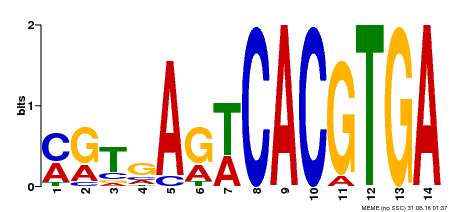 |
PlantRegMap/PlantTFDB v5.0
Plant Transcription
Factor Database
|
| Home TFext BLAST Prediction Download Help About Links PlantRegMap |
Transcription Factor Information
| Basic Information? help Back to Top | |||||||||
|---|---|---|---|---|---|---|---|---|---|
| TF ID | 676713048 | ||||||||
| Organism | |||||||||
| Taxonomic ID | |||||||||
| Taxonomic Lineage |
cellular organisms; Eukaryota; Viridiplantae; Streptophyta; Streptophytina; Embryophyta; Tracheophyta; Euphyllophyta; Spermatophyta; Magnoliophyta; Mesangiospermae; eudicotyledons; Gunneridae; Pentapetalae; rosids; malvids; Brassicales; Brassicaceae; Sisymbrieae; Sisymbrium
|
||||||||
| Family | bHLH | ||||||||
| Protein Properties | Length: 214aa MW: 24727.6 Da PI: 5.2659 | ||||||||
| Description | bHLH family protein | ||||||||
| Gene Model |
|
||||||||
| Signature Domain? help Back to Top | |||||||
|---|---|---|---|---|---|---|---|
| No. | Domain | Score | E-value | Start | End | HMM Start | HMM End |
| 1 | HLH | 33.6 | 6.9e-11 | 38 | 81 | 7 | 55 |
HHHHHHHHHHHHHHHHHHCTSCCC...TTS-STCHHHHHHHHHHHHHHH CS
HLH 7 erErrRRdriNsafeeLrellPkaskapskKlsKaeiLekAveYIksLq 55
e+ErrRR+++ ++ Lr+++P + ++Ka+i+e A+ YI +Lq
676713048 38 EAERRRREKLHGRLMALRSHVPIV-----TNMTKASIVEDAISYIGELQ 81
79*********************8.....69****************98 PP
| |||||||
| Protein Features ? help Back to Top | ||||||
|---|---|---|---|---|---|---|
| Database | Entry ID | E-value | Start | End | InterPro ID | Description |
| SuperFamily | SSF47459 | 9.55E-16 | 30 | 96 | IPR011598 | Myc-type, basic helix-loop-helix (bHLH) domain |
| PROSITE profile | PS50888 | 14.488 | 31 | 80 | IPR011598 | Myc-type, basic helix-loop-helix (bHLH) domain |
| CDD | cd00083 | 1.50E-10 | 33 | 85 | No hit | No description |
| SMART | SM00353 | 1.2E-12 | 37 | 86 | IPR011598 | Myc-type, basic helix-loop-helix (bHLH) domain |
| Gene3D | G3DSA:4.10.280.10 | 6.8E-14 | 38 | 96 | IPR011598 | Myc-type, basic helix-loop-helix (bHLH) domain |
| Pfam | PF00010 | 1.5E-8 | 38 | 81 | IPR011598 | Myc-type, basic helix-loop-helix (bHLH) domain |
| Gene Ontology ? help Back to Top | ||||||
|---|---|---|---|---|---|---|
| GO Term | GO Category | GO Description | ||||
| GO:0006355 | Biological Process | regulation of transcription, DNA-templated | ||||
| GO:0048658 | Biological Process | anther wall tapetum development | ||||
| GO:0005634 | Cellular Component | nucleus | ||||
| GO:0003700 | Molecular Function | transcription factor activity, sequence-specific DNA binding | ||||
| GO:0043565 | Molecular Function | sequence-specific DNA binding | ||||
| GO:0046983 | Molecular Function | protein dimerization activity | ||||
| Sequence ? help Back to Top |
|---|
| Protein Sequence Length: 214 aa Download sequence Send to blast |
MGGGNIFQEP TRISRRRQVR KEKEEEVVNE SFKSPNLEAE RRRREKLHGR LMALRSHVPI 60 VTNMTKASIV EDAISYIGEL QKKVENLQEQ LHEMEEAPLD IDEQQMGRII KPEHETIDLE 120 EEIKKLKIEE NVQLCKIGEM KFWLKITAEK KPGIFTKFMD VMRFMGFEII DITLASSNGA 180 IVICSQILQG LCDGDSVDLQ QTKDFLLEVM RSNP |
| Nucleic Localization Signal ? help Back to Top | |||
|---|---|---|---|
| No. | Start | End | Sequence |
| 1 | 39 | 44 | ERRRRE |
| 2 | 40 | 45 | RRRREK |
| Functional Description ? help Back to Top | ||||||
|---|---|---|---|---|---|---|
| Source | Description | |||||
| UniProt | Transcription factor. Involved in the control of tapetum development. Required for male fertility and pollen differentiation, especially during callose deposition. {ECO:0000269|PubMed:16831835}. | |||||
| Binding Motif ? help Back to Top | |||
|---|---|---|---|
| Motif ID | Method | Source | Motif file |
| MP00091 | SELEX | Transfer from AT4G21330 | Download |

| |||
| Cis-element ? help Back to Top | |
|---|---|
| Source | Link |
| PlantRegMap | 676713048 |
| Regulation -- PlantRegMap ? help Back to Top | ||||||
|---|---|---|---|---|---|---|
| Source | Upstream Regulator | Target Gene | ||||
| PlantRegMap | Retrieve | Retrieve | ||||
| Annotation -- Nucleotide ? help Back to Top | ||||||
|---|---|---|---|---|---|---|
| Source | Hit ID | E-value | Description | |||
| GenBank | KF032299 | 1e-143 | KF032299.1 Sisymbrium irio self-incompatibility gene locus, complete sequence. | |||
| Annotation -- Protein ? help Back to Top | |||||||
|---|---|---|---|---|---|---|---|
| Source | Hit ID | E-value | Description | ||||
| Refseq | XP_018468643.1 | 1e-132 | PREDICTED: transcription factor DYT1 | ||||
| Swissprot | O81900 | 1e-107 | DYT1_ARATH; Transcription factor DYT1 | ||||
| TrEMBL | A0A078ID23 | 1e-124 | A0A078ID23_BRANA; BnaC03g64200D protein | ||||
| STRING | Bra013519.1-P | 1e-123 | (Brassica rapa) | ||||
| STRING | Bo3g162600.1 | 1e-125 | (Brassica oleracea) | ||||
| Orthologous Group ? help Back to Top | |||
|---|---|---|---|
| Lineage | Orthologous Group ID | Taxa Number | Gene Number |
| Malvids | OGEM8358 | 25 | 38 |
| Best hit in Arabidopsis thaliana ? help Back to Top | ||||||
|---|---|---|---|---|---|---|
| Hit ID | E-value | Description | ||||
| AT4G21330.1 | 1e-88 | bHLH family protein | ||||



